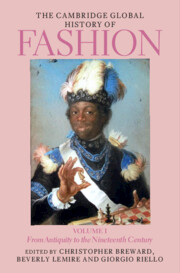Book contents
- The Cambridge Global History of Fashion
- The Cambridge Global History of Fashion
- The Cambridge Global History of Fashion
- Copyright page
- Contents for Volume I
- Figures for Volume I
- Maps for Volume I
- Table for Volume I
- Contributors for Volume I
- Preface
- 1 Global History in the History of Fashion
- Part I Multiple Origins of Fashion
- Part II Early Modern Global Entanglements
- Part III Many Worlds of Fashion
- 13 ‘Black Cloth’
- 14 Fashion and Moral Concern in Early Modern Japan
- 15 Textiles and Fashion in Southeast Asia
- 16 Fashion in Ming and Qing China
- 17 Everyday Fashion in the Ottoman Empire,C. 1600–1800
- 18 Imperialism and Fashion: South Asia, c. 1500–1800
- 19 Fashion Systems in the Indian Ocean World, from Ancient Times to c. 1850
- 20 Fashion and First Peoples in European Settler Societies, c. 1700–1850
- Index
- References
16 - Fashion in Ming and Qing China
from Part III - Many Worlds of Fashion
Published online by Cambridge University Press: 04 August 2023
- The Cambridge Global History of Fashion
- The Cambridge Global History of Fashion
- The Cambridge Global History of Fashion
- Copyright page
- Contents for Volume I
- Figures for Volume I
- Maps for Volume I
- Table for Volume I
- Contributors for Volume I
- Preface
- 1 Global History in the History of Fashion
- Part I Multiple Origins of Fashion
- Part II Early Modern Global Entanglements
- Part III Many Worlds of Fashion
- 13 ‘Black Cloth’
- 14 Fashion and Moral Concern in Early Modern Japan
- 15 Textiles and Fashion in Southeast Asia
- 16 Fashion in Ming and Qing China
- 17 Everyday Fashion in the Ottoman Empire,C. 1600–1800
- 18 Imperialism and Fashion: South Asia, c. 1500–1800
- 19 Fashion Systems in the Indian Ocean World, from Ancient Times to c. 1850
- 20 Fashion and First Peoples in European Settler Societies, c. 1700–1850
- Index
- References
Summary
Until fairly recently, fashion was viewed as of little relevance to Chinese history. It was not until the late 1990s that scholars began to challenge the assumption, demonstrated to have originated with eighteenth-century reports from Western observers, that China lacked the phenomenon of fashion until it was introduced by the West in the early twentieth century.1 As BuYun Chen’s chapter in this volume discusses, these new studies of fashion in historical China were part of a wider trend to contest the association between fashion, Western modernity, and capitalism. This scholarship spanned cultural history, literature studies, and museum exhibitions, but it shared a desire to look to new sources, rather than echo the court-issued and official texts that charted regulation and control.2 Scholars began to discuss vernacular and commercial texts that revealed histories of women and merchants, of entertainment and trade.3 Most of all, historians began to look beyond regulated court dress objects like rank badges and dragon robes, which had long fascinated Western collectors, to diverse objects including photographs, vernacular paintings, and prints, thus moving the field away from twentieth-century connoisseurship accounts.4
- Type
- Chapter
- Information
- The Cambridge Global History of FashionFrom Antiquity to the Nineteenth Century, pp. 533 - 570Publisher: Cambridge University PressPrint publication year: 2023



